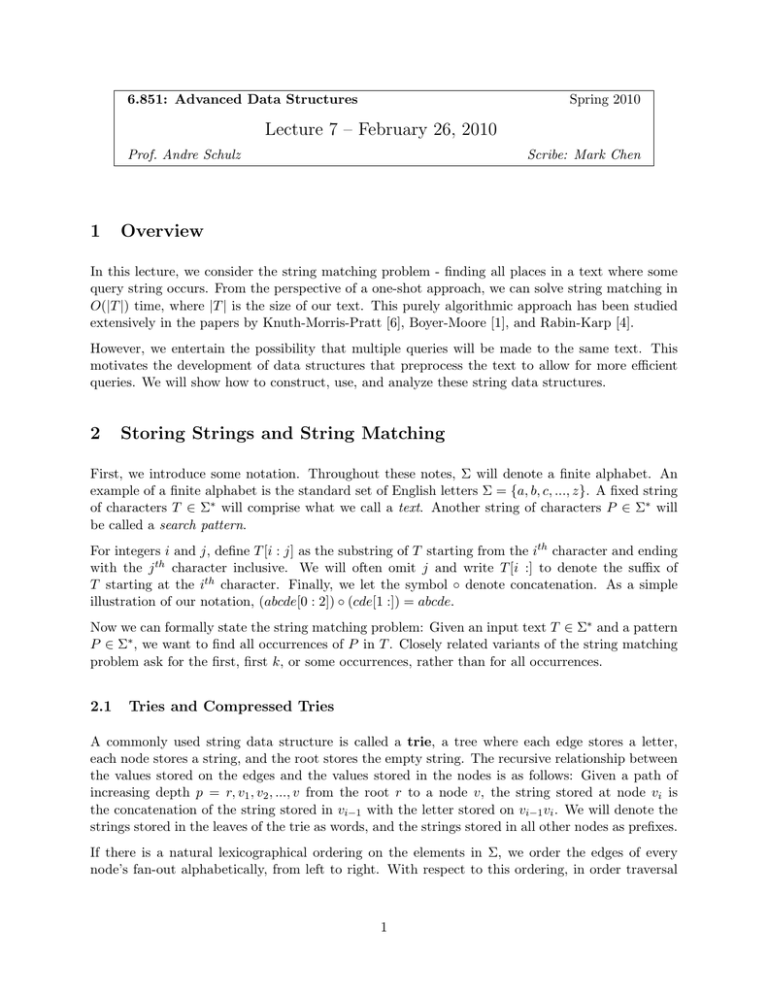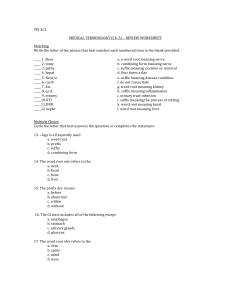Lecture 7 – February 26, 2010 1 Overview
advertisement

6.851: Advanced Data Structures
Spring 2010
Lecture 7 – February 26, 2010
Prof. Andre Schulz
1
Scribe: Mark Chen
Overview
In this lecture, we consider the string matching problem - finding all places in a text where some
query string occurs. From the perspective of a one-shot approach, we can solve string matching in
O(|T |) time, where |T | is the size of our text. This purely algorithmic approach has been studied
extensively in the papers by Knuth-Morris-Pratt [6], Boyer-Moore [1], and Rabin-Karp [4].
However, we entertain the possibility that multiple queries will be made to the same text. This
motivates the development of data structures that preprocess the text to allow for more efficient
queries. We will show how to construct, use, and analyze these string data structures.
2
Storing Strings and String Matching
First, we introduce some notation. Throughout these notes, Σ will denote a finite alphabet. An
example of a finite alphabet is the standard set of English letters Σ = {a, b, c, ..., z}. A fixed string
of characters T ∈ Σ∗ will comprise what we call a text. Another string of characters P ∈ Σ∗ will
be called a search pattern.
For integers i and j, define T [i : j] as the substring of T starting from the ith character and ending
with the j th character inclusive. We will often omit j and write T [i :] to denote the suffix of
T starting at the ith character. Finally, we let the symbol ◦ denote concatenation. As a simple
illustration of our notation, (abcde[0 : 2]) ◦ (cde[1 :]) = abcde.
Now we can formally state the string matching problem: Given an input text T ∈ Σ∗ and a pattern
P ∈ Σ∗ , we want to find all occurrences of P in T . Closely related variants of the string matching
problem ask for the first, first k, or some occurrences, rather than for all occurrences.
2.1
Tries and Compressed Tries
A commonly used string data structure is called a trie, a tree where each edge stores a letter,
each node stores a string, and the root stores the empty string. The recursive relationship between
the values stored on the edges and the values stored in the nodes is as follows: Given a path of
increasing depth p = r, v1 , v2 , ..., v from the root r to a node v, the string stored at node vi is
the concatenation of the string stored in vi−1 with the letter stored on vi−1 vi . We will denote the
strings stored in the leaves of the trie as words, and the strings stored in all other nodes as prefixes.
If there is a natural lexicographical ordering on the elements in Σ, we order the edges of every
node’s fan-out alphabetically, from left to right. With respect to this ordering, in order traversal
1
of the leaves gives us every word stored in the trie in alphabetical order. In particular, it is easy to
see that the fan-out of any node must be bounded above by the size of the alphabet |Σ|.
It is common practice to terminate strings with a special character $ ∈
/ Σ, so that we can distinguish
a prefix from a word. The example trie in Figure 1 stores the four words ana$, ann$, anna$, and
anne$.
If we assign only one letter per edge, we are not taking full advantage of the trie’s tree structure.
It is more useful to consider compact or compressed tries, tries where we remove the one letter
per edge constraint, and contract non-branching paths by concatenating the letters on these paths.
In this way, every node branches out, and every node traversed represents a choice between two
different words. The compressed trie that corresponds to our example trie is also shown in Figure
1.
a
n
an
a
$
ana
n
a e
$
ann
a$
$
anna
ana
$
n
$
ann
a$ e$
anna
anne
anne
Trie
Compacted Trie
(Pointers to nulls
are not shown)
Figure 1: Trie and Conmpacted Trie Examples
2.2
Suffix Trees
A suffix tree is a compact trie built on the |T | + 1 suffixes of T . For example, if our text is the
string T = banana$, then our suffix tree will be built on {banana$, anana$, nana$, ana$, na$, a$}.
For a non-leaf node of the suffix tree, define the letter depth of the node as the length of the prefix
stored in the node.
Storing strings on the edges and in the nodes is potentially very costly in terms of space. For
example, if all of the characters in our text are different, storage space is quadratic in the size of
the text. To decrease storage space of the suffix tree to O(|T |), we can replace the strings on each
2
edge by the indices of its first and last character, and omit the strings stored in each node. We lose
no information, as we are just removing some redundancies.
Suffix trees are versatile data structures that have myriad applications to string matching and
related problems:
• String Matching To solve the string matching problem, note that a substring of T is simply
a prefix of a suffix of T . Therefore, to find a pattern P , we walk down the tree, following the
edge that corresponds to the next set of characters in P . Eventually, if the pattern matches,
we will reach a node v that stores P . Finally, report all the leaves beneath v, as each leaf
represents a different occurrence. There is a unique way to walk down the tree, since every
edge in the fan out of some node must have a distinct first letter. Therefore, the total runtime
of string matching is O(|P | + k), where k denotes the size of the output.
• Counting Occurrences In this variant of the string matching problem, we must find the number
of times the pattern P appears in the text. However, we can simply store in every node the
size of the subtree at that node.
• Longest Repeating Substring To find the longest repeated substring, we look for the branching
node with maximum letter depth.
• Multiple Documents When there are multiple texts in question, we can concatenate them
with $1 , $2 , ..., $n . Then to find the longest common substring, we look for the node with the
maximum letter depth with greater than one distinct $ below.
Compared to binary search trees, suffix trees allow for faster queries and utilize less storage, especially for texts with a large number of suffixes. Compared to hash tables, suffix trees allow for
faster worst case queries, and avoid problems caused by collisions and computing hash functions.
3
Suffix Arrays
Suffix trees are powerful data structures with applications in fields such as computational biology,
data compression, and text editing. However, a suffix array, which contains most of the information in a suffix tree, is a simpler and more compact data structure for many applications. The only
drawback of a suffix array is that is that it is less intuitive and less natural as a representation. In
this section, we define suffix arrays, show that suffix arrays are in some sense equivalent to suffix
trees, and provide a fast algorithm for building suffix arrays.
3.1
Creating Suffix Arrays
Let us store the suffixes of a text T in lexicographical order in an intermediate array. Then the
suffix array is the array that stores the index corresponding to each suffix. For example, if our
text is banana$, the intermediate array is [$, a$, ana$, anana$, banana$, na$, nana$] and the suffix
array is [6, 5, 3, 1, 0, 4, 2]. Since suffixes are ordered lexicographically, we can use binary search to
search for a pattern P in O(|P | log |T |) time.
3
We can compute the length of the longest common prefix between neighboring entries of the intermediate array. If we store these lengths in an array, we get what is called the LCP array. These
LCP arrays can be constructed in O(|T |) time, a result due to Kasai et al [5]. In the example
above, the LCP array constructed from the intermediate array is [0, 1, 3, 0, 0, 2]. Using LCP arrays,
we can improve pattern searching in suffix arrays to O(|P | + log |T |) (see homework).
Suffix Tree built from LCP array
using Cartesian Trees
6
$
5
a$
3
ana$
1
anana$
0
banana$
4
na$
2
nana$
0
1
Correspond to visits
to the voot in the
in-order walk of the
suffix tree
a
$
3
2
banana$
1
Correspond to the
letter depth of internal
nodes in the in-order
walk of the suffix tree
$
$
na
Sorted
suffixes
of T
$
LCP
Array
Letter depth
na$
na$
nana$
3
a$
ana$
Suffix
Array
na
b
2
0
0
000
$
na$
anana$
We get the tree from
LCP Array and the
labels on the edges
from Suffix Array
Figure 2: Suffix Array and LCP Array examples and their relation to Suffix Tree
3.2
Suffix Arrays and Suffix Trees
To motivate the construction of a suffix array and a LCP array, note that a suffix array stores the
leaves of the corresponding suffix tree, and the LCP array provides information about the height
of internal nodes, as seen in Figure 2. Our aim now is to show that suffix trees can be transformed
into suffix arrays in linear time and vice versa.
To formalize this intuition, we define the Cartesian Tree of an LCP array. To build a Cartesian
tree, store the minimum over all LCP array entries at the root of the Cartesian tree, and recurse
on the remaining array pieces. For a concrete example, see Figure 3 below.
3.2.1
From Suffix Trees to Suffix Arrays
To transform a suffix tree into a suffix array, we simply run an in-order traversal of the suffix tree.
As noted earlier, this process returns all suffixes in alphabetical order.
4
3.2.2
From Suffix Arrays to Suffix Trees
To transform a suffix array back into a suffix tree, create a Cartesian tree from the LCP array
associated to the suffix array. The numbers stored in the nodes of the Cartesian tree are the letter
depths of the internal nodes! Hence, if we insert the entries of the suffix array in order into the
Cartesian tree as leaves, we recover the suffix tree. In fact, we are rewarded with an augmented
suffix tree with informationa bout the letter depths.
Put smallest elements in array at root node
0 1 3 0 0 2
Recurse on (possibly empty) sub­
branches between the zeros
Eventual Cartesian tree
0
Eventual suffix tree
0
0
0
1
6
2
0
1
3
5
3
0
0
3
2
4
2
1
Figure 3: Constructing the Cartesian tree and suffix tree from LCP array
3.3
DC3 Algorithm for Building Suffix Arrays
Here, we give a description of the DC3 (Difference Cover 3) divide and conquer algorithm for
building a suffix array in O(|T | + sort(Σ)) time. We closely follow the exposition of the paper by
Karkkainen-Sanders-Burkhardt [3] that originally proposed the DC3 algorithm. Because we can
create suffix trees from suffix arrays in linear time, a consequence of DC3 is that we can create suffix
trees in linear time, a result shown independently of DC3 by Farach [2], McCreight [7], Ukkonen
[9], and Weiner [10]
1. Sort the alphabet Σ. We can use any sorting algorithm, leading to the O(sort(Σ)) term.
2. Replace each letter in the text with its rank among the letters in the text. Note that the rank
of the letter depends on the text. For example, if the text contains only one letter, no matter what
letter it is, it will be replaced by 1. This operation is safe, because it does not change any relations
we are interested in. We also guarantee that the size of the alphabet being used is no larger than
the size of the text (in cases where the alphabet is excessively large), by ignoring unused alphabets.
3. Divide the text T into 3 parts and package triples of letters into megaletters. More formally,
form T0 , T1 , and T2 as follows:
T0 = < (T [3i], T [3i + 1], T [3i + 2])
for
i = 0, 1, 2, . . . >
T1 = < (T [3i + 1], T [3i + 2], T [3i + 3])
for
i = 0, 1, 2, . . . >
T2 = < (T [3i + 2], T [3i + 3], T [3i + 4])
for
i = 0, 1, 2, . . . >
Note that Ti ’s are just texts with n/3 letters of a new alphabet Σ3 . Our text size has become a
third of the original, while the alphabet size has cubed.
5
4. Recurse on < T0 , T1 >, the concatenation of T0 and T1 . Since our new alphabet is of cubic
size, and our original alphabet is pre-sorted, radix-sorting the new alphabet only takes linear time.
When this recursive call returns, we have all the suffixes of T0 and T1 sorted in a suffix array. Then
all we need is to sort the suffixes of T2 , and to merge them with the old suffixes to get suffixes of
T, because
Suffixes(T ) ∼
= Suffixes(T0 ) ∪ Suffixes(T1 ) ∪ Suffixes(T2 )
If we can do this sorting and merging in linear time, we get a recursion formula T (n) = T (2/3n) +
O(n), which gives linear time.
5. Sort suffixes of T2 using radix sort. This is straight forward to do once we note that
T2 [i :] ∼
= T [3i + 2 :] ∼
= (T [3i + 2], T [3i + 3 :]) ∼
= (T [3i + 2], T0 [i + 1 :]).
The logic here is that once we rewrite T2 [i :] in terms of T , we can pull off the first letter of the
suffix and pair it with the remainder. We end up with something where the index 3i+3 corresponds
with the start of a triplet in T0 , specifically, T0 [i + 1], which we already have in sorted order from
our recursive call.
Thus, we can radix sort on two coordinates, the triplet T0 [i + 1] and then the single alphabet
T [3i + 2], both of which we know the sorted orders of. This way, we get T2 [i :] in sorted order.
Specifically, the radix sort is just on two coordinates, where the second coordinate is already sorted.
6. Merge the sorted suffixes of T0 , T1 , and T2 using standard linear merging. The only problem
is finding a way to compare suffixes in constant time. Remember that suffixes of T0 and T1 are
already sorted together, so comparing a suffix from T0 and a suffix from T1 takes constant time.
To compare against a suffix from T2 , we will once again decompose it to get a suffix from either T0
or T1 . There are two cases:
• Comparing T0 against T2 :
∼
=
T0 [i :]
∼
T [3i :]
=
(T [3i], T [3i + 1 :])
vs
T2 [j :]
vs
T [3j + 2 :]
vs
(T [3j + 2], T [3j + 3 :])
(T [3i], T1 [i :])
vs
(T [3j + 2], T0 [j + 1 :])
∼
=
So we just compare the first letter and then, if needed, compare already sorted suffixes of T0
and T1 .
• Comparing T1 against T2 :
∼
=
∼
=
T1 [i :]
∼
T [3i + 1 :]
=
(T [3i + 1], T [3i + 2], T [3i + 3 :])
vs
T2 [j :]
vs
T [3j + 2 :]
vs
(T [3j + 2], T [3j + 3], T [3j + 4 :])
(T [3i + 1], T [3i + 2], T0 [i + 1 :])
vs
(T [3j + 2], T [3j + 3], T1 [j + 1 :])
So we can do likewise by first comparing the two letters in front, and then comparing already
sorted suffixes of T0 and T1 if necessary.
6
4
Document Retrieval
The statement of the document retrieval problem is as follows: Given a collection of texts {T1 , T2 , ..., Tn },
we want to find all distinct documents that contain an instance of a query pattern P . Naively, we
can store the suffixes of the text T = T1 ◦ $1 ◦ T2 ◦ $2 ◦ ... ◦ Tn ◦ $n in a suffix tree and query for
the pattern. However, the result of this query will include multiple matches of P within the same
text, whereas we only want to find which texts contain P . Hence, a simple query doesn’t give us
the answer we want, and is costlier than we would like. The fix we present will follow the paper by
Muthukrishan [8].
Consider the suffix array A of the augmented text T . The node corresponding to a pattern P in
the suffix tree corresponds to some interval [i, j] in the suffix array. Now the texts containing the
pattern are precisely the indices of all the dollar signs appearing in the interval [i, j] in A. Hence,
solving document retrieval is equivalent to finding the position of the first dollar sign of each type
within the interval [i, j], as the suffixes at those positions cannot contain repeats of P .
To this end, augment the suffix array by connecting each dollar sign of a given type to the previous
dollar sign of the same type. Then the queries can be answered with a Range Minimum Data
Structure. In particular, this gives us a O(|P | + d) runtime, where d is the number of texts to
report.
References
R. Boyer and J. Moore. A fast string searching algorithm. Communications of the ACM,
20(10):762772, 1977.
M. Farach. Optimal suffix tree construction with large alphabets. In Proc. 38th Annual Symposium
on Foundations of Computer Science, pages 137143. IEEE, 1997.
Juha Karkkainen, Peter Sanders, Simple linear work suffix array construction, In Proc. 30th International Colloquium on Automata, Languages and Programming (ICALP03). LNCS 2719, Springer,
2003, pp. 943-955
R. M. Karp and M. O. Rabin. Efficient randomized pattern-matching algorithms. IBM Journal of
Research and Development, 31:249260, March 1987.
T. Kasai, G. Lee, H. Arimura, S. Arikawa, and K. Park. Linear-time longest-common-prefix computation in suffix arrays and its applications. In Proc.12th Symposium on Combinatorial Pattern
Matching (CPM 01), pages 181192. Springer-Verlag LNCS n. 2089, 2001.
D. E. Knuth, J. H. Morris, and V. R. Pratt. Fast pattern matching in strings. SIAM Journal of
Computing, 6(2):323350, 1977.
E. M. McCreight. A space-economic suffix tree construction algorithm. J. ACM,23(2):262272, 1976.
S. Muthukrishnan, Efficient algorithms for document retrieval problems. SODA 2002: 657-666
E. Ukkonen. On-line construction of suffix trees. Algorithmica, 14(3):249260, 1995.
7
P. Weiner. Linear pattern matching algorithm. In Proc. 14th Symposium on Switching and Automata Theory, pages 111. IEEE, 1973.
8




